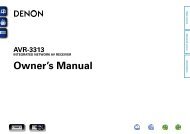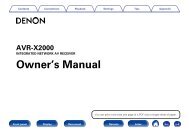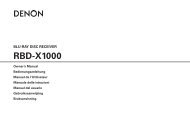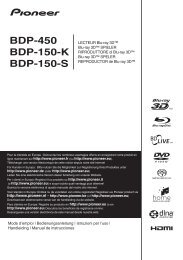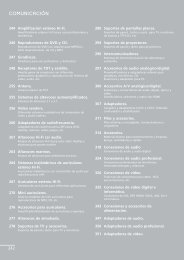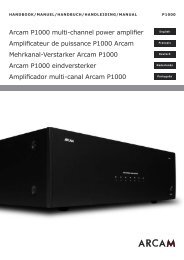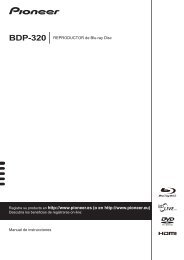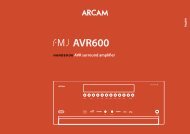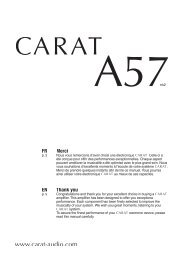Dynaudio SUB 300/500 - Studio 22
Dynaudio SUB 300/500 - Studio 22
Dynaudio SUB 300/500 - Studio 22
Erfolgreiche ePaper selbst erstellen
Machen Sie aus Ihren PDF Publikationen ein blätterbares Flipbook mit unserer einzigartigen Google optimierten e-Paper Software.
Positioning and Optimizing<br />
Multi-channel<br />
bass-management system<br />
Loudspeakers<br />
with full-range signal<br />
Many multi-channel processors and receivers provide elaborate bass-management<br />
systems where the cross-over frequency for both subwoofer and main speakers can<br />
be set. If you are using such a bass-management system, you can select the Flat<br />
setting on the subwoofer's remote control, as all filtering has been done by the bassmanagement<br />
system. Carefully follow the instructions for the amplifier/processor or<br />
receiver.<br />
Note<br />
• If you are using your system's bass-management system, ensure that the<br />
subwoofer's cross-over frequency hasn't been set to the same or lower frequency<br />
compared to the setting chosen with the bass management system.<br />
• Selecting the correct frequency depends to a large extend on the main speakers.<br />
Sometimes main speakers are specifically intended to work with a subwoofer. In<br />
such cases, the main speakers can get damaged by a full-range amplifier signal. If<br />
in doubt, check the operating guide for the main speakers for any restrictions or<br />
recommendations.<br />
Of course it is possible to combine the subwoofer in a system where the loudspeakers<br />
are being fed with a full-range signal. In that case, setting the cross-over frequency<br />
for the subwoofer depends very much on the natural roll-off frequency in the bass of<br />
the main speakers. In general, a large, floor-standing speaker will still have significant<br />
output in the deeper bass range, in which case the cross-over frequency should be<br />
set to 60 Hz. A small or very small speaker will have less deep bass output in which<br />
case the setting should be 80 Hz or 100 Hz. To find the correct setting in such<br />
scenarios:<br />
Play a music track that has a significant amount of bass over a large bass region.<br />
An instrument such as a double-bass or bass-guitar is very suitable. Starting with<br />
the 60 Hz position, use this track to set the subwoofer's relative volume level.<br />
Listen carefully to the bass-line played by the instrument. As it goes up and down<br />
in the bass range, the overall bass volume should remain the same, be it with very<br />
deep or higher bass notes. Particularly with very small main speakers, it may be<br />
that you can hear a “hole” in the bass response: You can hear the deepest bass<br />
notes and everything from lower midrange easily, but overall the bass leaves a thin<br />
impression. On the other hand, it may be that using the 60 Hz setting the system<br />
already sounds good. In both cases, select the next setting, 80 Hz.<br />
Playing the same track at the same volume level, again listen to the overall bass<br />
volume level. Should the bass volume suddenly become louder or bloated at<br />
certain tones compared to the 60Hz setting earlier, revert to this setting; in this<br />
case setting the cross-over frequency is done. If the apparent hole in bass<br />
response is still present or if the system sounds good now, move on to the next<br />
setting, 100 Hz.<br />
Again play the track to listen to the overall bass volume level. Should the bass<br />
volume suddenly become louder or bloated at certain tones compared to the 80 Hz<br />
setting earlier, revert to this setting. If the bass sounds correct now, leave the<br />
setting at 100 Hz.<br />
<strong>Dynaudio</strong> <strong>SUB</strong> <strong>300</strong>/<strong>500</strong> 19



